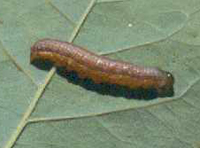Armyworms
Pest Management Fact Sheet #5040
Mythimna unipuncta (Haworth)
Order: Lepidoptera
Family: Noctuidae
James F. Dill, Pest Management Specialist
Clay A. Kirby (retired), Insect Diagnostician
Charles D. Armstrong, Cranberry Professional & Staff Entomologist
For information about UMaine Extension programs and resources, visit extension.umaine.edu.
Find more of our publications and books at extension.umaine.edu/publications/.
Biology
The adult armyworm (Mythimna unipuncta; formerly Pseudaletia unipuncta), is a moth captured in Maine in light traps in late April and early May. The female moth mates and begins laying eggs in mid-May. The eggs hatch in approximately 10 days, depending on temperature. Larvae feed for three to four weeks and then pupate in the soil, emerging as adult moths after about two to three more weeks. This process is repeated again, producing a third generation. In September, this third generation of nearly full-grown caterpillars spend the winter in the soil.
In the spring, the caterpillars finish growing and pupate from mid-April to early May. Two to three weeks later, the moths emerge, mate, and lay first-generation eggs. One female moth can lay several hundred eggs.
- Adult
- Larva
Description and Feeding Habits
When full-grown, the caterpillars can be almost 1.5 inches long. The caterpillars are usually greenish or brownish, but can also be nearly black. The sides and back of the caterpillar have light-colored stripes running along the body.
The caterpillars normally feed at night, and much damage can occur before they mature. The preferred foods are grasses, including corn, grains and timothy. They will feed on other plants if grasses are unavailable. Once the grass has been devoured, the caterpillars will move in a mass and ‘march’ into other fields of suitable hosts; hence the name ‘armyworm.’
The first generation of caterpillars–those feeding in June–are usually the most destructive. Rarely are there outbreaks with the second or third generation of caterpillars.
The moths are tan or light brown in color with a white dot in the center of each front wing and a dark area on the edge of each hind wing. The moths feed on nectar and possibly on overripe fruit. The females lay their light-green eggs at night on the underside of grasses. Many moths congregate in a local area and lay their eggs, which may lead to the first-generation outbreaks.
Management
By the time damage is seen (destroyed grain, corn, hay, or lawns) it is often too late to control armyworm caterpillars, and by that point they are almost fully grown so will not feed much more. However, that is not always the situation. If a spotty infestation is found in a field, a 30 to 40-ft wide perimeter spray around the infested area may prevent further infestation. Since the caterpillars usually feed at night, the best time to spray is late in the day.
To prevent the caterpillars from moving to another field, apply a 40-ft border spray around the non-infested field. Residual pyrethroids (e.g. Warrior II®, Asana®, Pounce®, etc.) may offer some control.
For home use, carbaryl (Sevin®) may have some effect. Organic controls include pyrethrum, pyrethrins, or a combination of pyrethrins and spinosad. However, the pyrethrum/pyrethrins do not provide residual control. Formulations of Bt-k (Bacillus thuringiensis, kurstaki strain) are effective in controlling smaller caterpillars. Be sure to read and follow the label instructions and make sure the product is registered for the intended use.
Other management strategies include keeping lawns mowed short to make them less attractive to the caterpillars. If a lawn is infested, mowing it short will kill many of the caterpillars and reduce their food source. Hayfields can be mowed to salvage the crop, but many of the “worms” will survive and move elsewhere, looking for a new food source. Therefore, neighboring grasses should be protected before mowing.
Usually when the armyworms are on the move they are fairly mature and robust, making them harder to kill with insecticides.
Armyworm Damage
- A field in South Waldoboro, Maine, showing armyworm damage (week of July 4, 2001).
- Mature or nearly mature armyworms
- Corn field damage from armyworms in Solon, Maine. Photo by Rick Kersbergen.
When Using Pesticides
Always Follow Label Directions!
Pest Management Unit
Cooperative Extension Diagnostic and Research Laboratory
17 Godfrey Drive, Orono, ME 04473
1.800.287.0279 (in Maine)
Information in this publication is provided purely for educational purposes. No responsibility is assumed for any problems associated with the use of products or services mentioned. No endorsement of products or companies is intended, nor is criticism of unnamed products or companies implied.
© 2010. Revised/Updated: 2023 and 2025.
Call 800.287.0274 (in Maine), or 207.581.3188, for information on publications and program offerings from University of Maine Cooperative Extension, or visit extension.umaine.edu.
The University of Maine System (the System) is an equal opportunity institution committed to fostering a nondiscriminatory environment and complying with all applicable nondiscrimination laws. Consistent with State and Federal law, the System does not discriminate on the basis of race, color, religion, sex, sexual orientation, transgender status, gender, gender identity or expression, ethnicity, national origin, citizenship status, familial status, ancestry, age, disability (physical or mental), genetic information, pregnancy, or veteran or military status in any aspect of its education, programs and activities, and employment. The System provides reasonable accommodations to qualified individuals with disabilities upon request. If you believe you have experienced discrimination or harassment, you are encouraged to contact the System Office of Equal Opportunity and Title IX Services at 5713 Chadbourne Hall, Room 412, Orono, ME 04469-5713, by calling 207.581.1226, or via TTY at 711 (Maine Relay System). For more information about Title IX or to file a complaint, please contact the UMS Title IX Coordinator at www.maine.edu/title-ix/.






